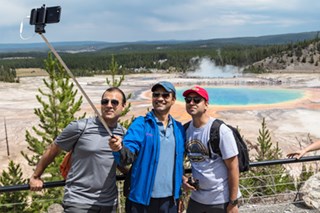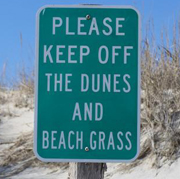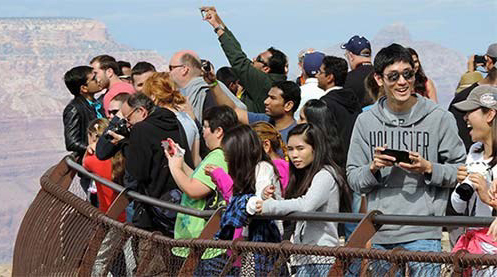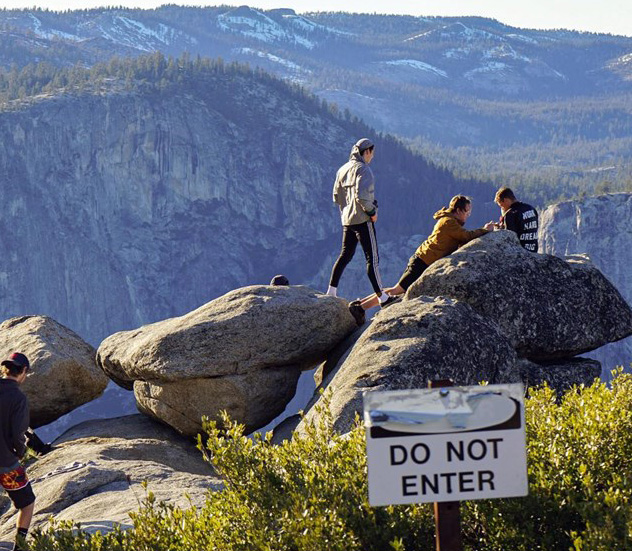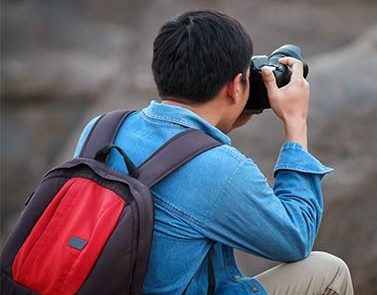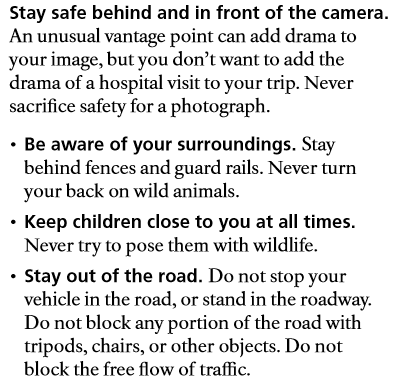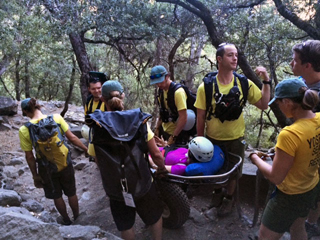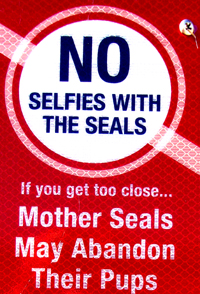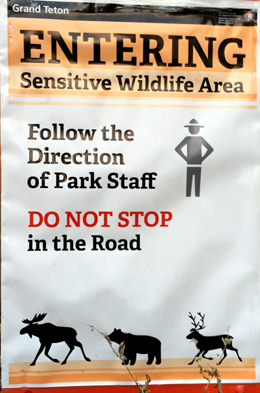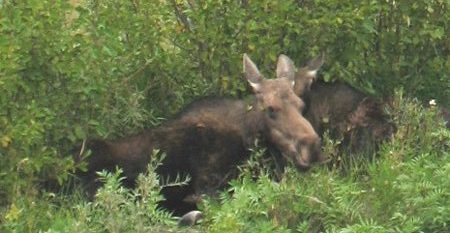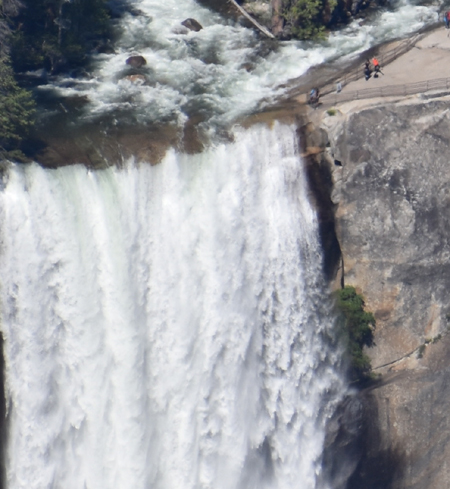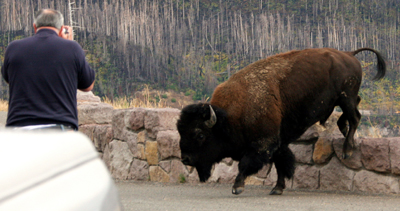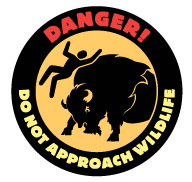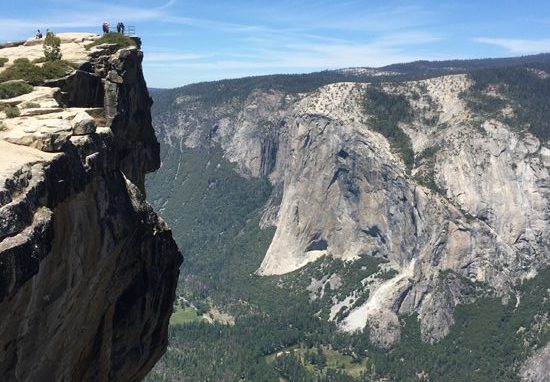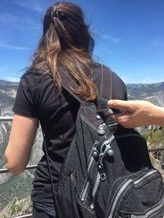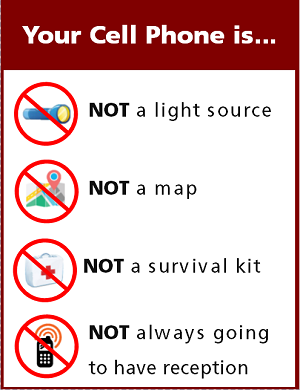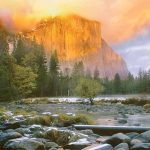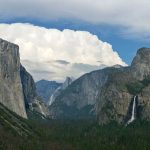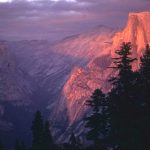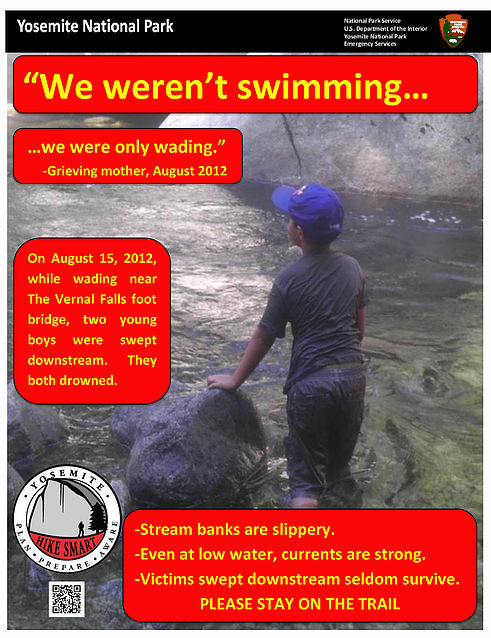People do not always pay attention to what is going on around them when they are taking photos.
(As a result the wedding picture has a telephone pole, or thin tree in the background seeming to sprout from the bride’s head).
But the use of cell phones for photography (with or without a selfie stick) has made preventable injury or even death by selfie common.
People don’t notice the space a selfie stick takes (and swing around and hit someone else). Their smart-enough phone does not have enough zoom to get close enough for a photo they want, so they get too close to wild animals. They are so engrossed in taking the picture that they do not notice they are on bad footing and they step where they should not, including off cliffs and into swift moving rivers. (Some examples from National Park Service reports are below.)
When taking a selfie, you are often walking backwards, concentrating on and enjoying what you want to get in the background and not really paying full attention to your footing, how close you are getting to the edge of that waterfall, what is going on behind you such as the herd of animals starting to move in your direction, etc.
– – – – – – – – – – – – – – – – – – – – – – – – – – – – – – – – – – – – – – – – – – – – – – – – – – – – – – – – – –
This group in a NPS photo is at a safe viewpoint, far away from the boiling water of the spring they have in their photo background and not in the way of other people:
– – – – – – – – – – – – – – – – – – – – – – – – – – – – – – – – – – – – – – – – – – – – – – – – – – – – – – – – – –
Signs can give you warnings to protect yourself
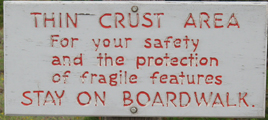
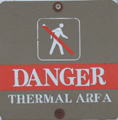
or protect fragile plants, bird nests on the ground
(entire fields of wildflowers during a superbloom have been trampled by photographers):
– – – – – – – – – – – – – – – – – – – – – – – – – – – – – – – – – – – – – – – – – – – – – – – – – – – – – – – – – –
Some selfie (and other photography) safety advice / injury prevention includes, but is not limited to:
Pictures should be taken from safe viewpoints, preferably fenced in. Stay behind and do not lean over / climb over / stand on the guardrails and retaining walls.
Many theme parks, stadiums, music festivals and museums are now banning “selfie sticks, hand-held extension poles for cameras or mobile devices,” in part because people are not careful with them while among other people, especially in crowds, and injuries have occurred. Museums and galleries ban them because they pose a risk to the antiquities and works of art (as well as other museum patrons). When you have the selfie stick out, be careful where you swing it that you do not hit someone or something.
Standing in or very near a road and assuming that drivers will see you is not wise. They are watching the scenery and might not see you even in bright yellow glow-in-the-dark reflective clothes.
Likewise the edge of, or even close to a cliff/river is dangerous. Stay on the walkway/designated trail/bridge. Many people go off-trail (destroying plants in the process) and the paths they wear out look like trails, but are not and they are frequently not as safe as the designated / maintained trails.
Photographers should stop and look around them before they take a shot, and stand still while taking it. Watch your footing when surfaces are wet / sandy / icy / slippery (or just dry polished granite surfaces coated with a layer of fine, sandy soil, the usual on many park trails) and wear appropriate footwear all the time. (Yup, slick-soled flip-flops are not good adventuring gear.)
People have fallen off the rim of the Grand Canyon while trying to get close for a photo.
Grand Canyon Park warns:
“Stay on designated trails and walkways and always keep a safe distance from the edge of the rim. In areas where there is a railing or fence, do not climb over the barrier.
Keep an eye on all of the people in your group, especially small children. Make sure that your travel companions have both feet firmly planted on pavement or developed trails at all times.
Know where the edge is. Watch foot placement and look for trip hazards.
Do not run, jump, or perform physical stunts when near the rim.”
Note that some view points can become too crowded mid-day to be able to take the photo you want:
and too many people in front of you raising their cell phone to get a photo of Old Faithful erupting means you get a photo of of people with their cell phones in the air, (so check out the area for viewpoints other than the bleachers):

Never turn your back on the ocean. Many people don’t realize that smaller and mid-size rogue waves occur regularly along the coast. People sightseeing on shore which has relatively dry sand can be hit by a wave that seems to come out of nowhere, a sleeper or sneaker wave. People who thought they were safely up on a jetty or low cliff, far enough away from where the waves were breaking, can be splashed and thoroughly soaked, or even swept off the cliff and slammed into it.
If you do the Yosemite hike that includes going up the Half Dome cables, stay inside the cables and keep your hands on the cables. Save the selfie for once you are at the top safely away from the edge.
See also: Backpacking advice and hiking advice
____________________________________________________
____________________________________________________
Yes, the rocks these people are climbing on are right at the edge of a cliff.
This bride and groom ignored the warning sign at Glacier Point.
When he miss-stepped and slipped a little, the group with them, and on-lookers, gasped.
But no one had heard anyone discouraging them from going out past the warning sign.
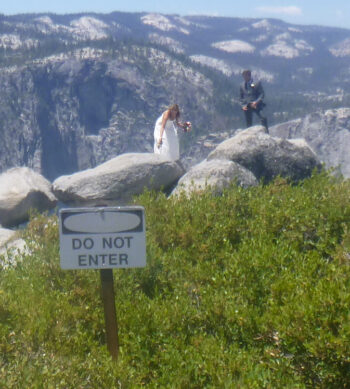
____________________________________________________
____________________________________________________
No tripod for your telephoto, or not enough time to get one out?
Try this advice from the National Park Service:
“Use your zoom, and to steady your shot, touch your elbows to your ribcage, or rest your elbows on your knee or another stable surface.”
– – – – – – – – – – – – – – – – – – – – – – – – – – – – – – – – – – – – – – – – – – – – – – – – – – – – – – – – – –
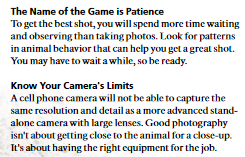
– – – – – – – – – – – – – – – – – – – – – – – – – – – – – – – – – – – – – – – – – – – – – – – – – – – – – – – – – –
– – – – – – – – – – – – – – – – – – – – – – – – – – – – – – – – – – – – – – – – – – – – – – – – – – – – – – – – – –
And in Yosemite, and example of
why you do not want to perform physical stunts on trails far from help:
“A Picture for Social Media Results in Injury and Carryout
October 14, 2014 Posted by: Yosemite Search and Rescue
On Tuesday, September 2, the Yosemite Emergency Communications Center received a cell phone call from a hiker on the Yosemite Falls Trail requesting help for a member of the hiker’s group. According to the hiker, a 28-year-old woman had slipped and fallen onto a rock. The subject had broken several teeth and was bleeding profusely. The hiker stated that the group was at Columbia Rock, which is approximately one mile up the Yosemite Falls Trail.
A ranger-paramedic started up the trail and located the subject approximately fifteen minutes up the trail. The subject had severely injured her mouth. Three other adults were with the subject. According to the hiker who reported the accident, while the group was at Columbia Rock, they decided to take a jumping photo to post on social media. The group of hikers, including the subject, had all jumped and tucked their legs behind them. When the subject landed, she slipped forward on gravel and face-planted on a rock. The group of hikers was able to start hiking down trail until they met up with the ranger-paramedic.
The ranger-paramedic administered pain medication to the subject. Typically, the medication makes people dizzy, so the ranger-paramedic requested a litter team to carry out the subject. A litter team was assembled and reached the subject within thirty minutes of the request.
Yosemite Search and Rescue (YOSAR) can extract an ill or injured party out of the backcountry on crutches, by horseback, or even by helicopter, but in most cases, YOSAR utilizes a litter carry out team. For this incident, a litter carry out was the best option. A litter team is comprised of at least six people (ideally more), a metal litter (the basket the subject lies in) and an ATV wheel that attaches to the bottom of the litter. The subject is strapped into the litter, the wheel is screwed onto the bottom of the litter, and then three people hold each side of the litter and guide the wheeled litter along the trail. Additional rescuers can act as a break for the litter, or the horsepower for the litter, pulling from either end of the litter depending on the slope of the terrain.
Because the subject was only fifteen minutes up the trail, six YOSAR personnel, in addition to the ranger-paramedic already on scene, could safely extract the subject. If the carryout had been longer, if the terrain had been more strenuous, or if the subject had been heavier, the litter team would have included more rescuers. While there is no exact formula for the number of rescuers to send on a litter carry out, more is usually better. Often, rescuers will have to maneuver difficult terrain in precarious areas, navigate in the dark or poor weather conditions, all the while attempting to get the subject to definitive care as quickly as possible. On the other hand, the incident command team is always mindful that in Yosemite it is not uncommon for multiple rescues to take place at the same time, and to adjust accordingly the number of rescuers committed to each rescue.
While the subject in this particular rescue fell while jumping, she could have just as easily suffered the same injury on the same trail while walking. Sloped, gravel-covered surfaces comprise the majority of the Yosemite Falls Trail, and ground-level falls are common. Be aware that even the most experienced hiker can turn an ankle or slip on any trail, and take care to stack the odds in your favor. While good preparation won’t guarantee you will complete your hike safely, it will greatly increase your chances of arriving at the trailhead injury free.
Wear sturdy footwear with good traction.
Drink plenty of water and eat snacks regularly.
Know your fitness level and pay attention to how you are feeling during your hike.
Tell someone responsible where you are going and when you expect to return.”
The there is no guarantee of rescue webpage
includes accident prevention tips many people who are experienced hikers and backpackers do not know about.
– – – – – – – – – – – – – – – – – – – – – – – – – – – – – – – – – – – – – – – – – – – – – – – – – – – – – – – – – –
It is actually illegal to approach animals too closely including stopping and getting out of your car (even really quickly) to take a photo of an animal if it is too close. You must move on.
A national park report noted: “Danger signs are not there to ruin our fun. They are often posted in places with a large accumulation of past accidents.”
A national park might have a rule such as:
“The following activities are prohibited:
a) Willfully approaching, remaining, viewing, or engaging in any activity within 100 yards of bears or wolves, or within 25 yards of any other wildlife including nesting birds; or within any distance that disturbs, displaces or otherwise interferes with the free unimpeded movement of wildlife, or creates or contributes to a potentially hazardous condition or situation.
b) Failure to remove one’s self to prescribed distances during inadvertent, accidental, casual or surprise encounters with wildlife.
c) Failure to comply as directed by NPS staff (employees, volunteers, or agents) engaged in administering wildlife management operations or managing wildlife viewing opportunities.”
And yes, some people truly do not understand that animals in park are wild and you should not try to pet them, hug them, hold your child close for a photo, try to “rescue” an animal / bird you think is separated from it’s parents etc.
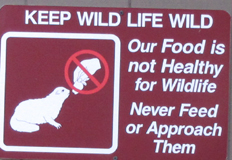
(Cute little squirrels that look so hungry can have diseases you don’t want, like plague.)
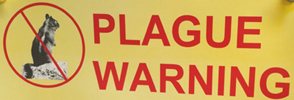
For your safety while wildlife viewing, stay 25 yards away, at least, for most wildlife, and 100 yards for bears, moose, elk, bison and wolves, whether on foot or in your car.
Keep the animal’s line of travel or escape route clear and move away if wildlife approaches you.
How far away is 100 yards? Picture the length of a football field without the end zones.
25 yards? picture four car lengths or six kayak lengths, or the width of an Olympic-sized pool like ours at the college.
If you have an accidental, surprise or inadvertent closer encounter with wildlife you must remove yourself to those distances, including while driving on a road.
Grand Canyon National Park rangers say: “Follow the rule of thumb: if you can cover the entire wild animal with your thumb you’re at a safe distance. This distance is usually 25 yards from most wildlife and 100 yards from large wildlife . . .
If you are close enough to take a selfie with an animal, you are too close. ”
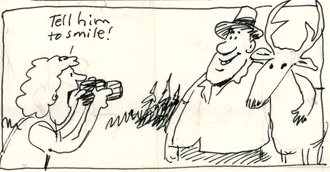
Parks Canada warns, along with keeping a proper distance from animals :
“If you spot the following defensive warning signals, pull back even more or leave the area:
Bears make a ‘woofing’ noise, growl and snap their jaws;
Bull elk and moose put their heads down and paw at the ground;
Cow elk flatten their ears, stare directly at you and raise their rump hair.
If you cause an animal to move, you are too close.”
And again, this page can’t list all the dangers you or friends or bystanders might cause.
You will really want your own binoculars.
and a telephoto lens for your camera.
You can stay far enough away from animals if you have a telephoto,
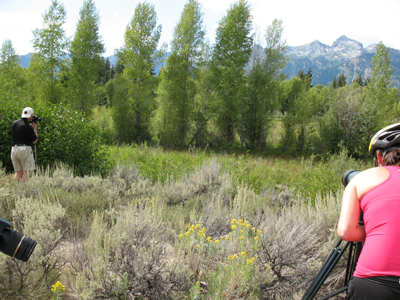
and get a photo of animals other people won’t even be able to see:
– – – – – – – – – – – – – – – – – – – – – – – – – – – – – – – – – – – – – – – – – – – – – – – – – – – – – – – – – –
From the Los Angeles Times:
“The Los Angeles County Sheriff’s Department’s Search and Rescue teams conducted 681 missions in 2017, the largest number in five years. It’s a 38% increase from the 491 rescues they did in 2013.
The teams’ leaders say the single largest factor for that increase is people posting videos of extreme activities online.
Then, without any thought about the difficulty, others try to re-create their own 15-second version of glory.”
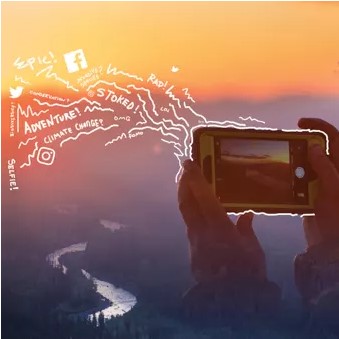
Parks are asking that people
“Reduce the Impact of Social Media
• Encourage positive behavior. Posting about conservation, leave no trace, and safety helps spread the word and supports the mission of the National Park Service.
• Avoid geotagging or giving directions to areas off trail. Some sensitive areas are being destroyed by crowds seeking out these spots for the perfect social media photo.
• Don’t post a selfie while engaging in illegal activities like feeding wildlife. Also, if park officers see those kinds of posts, you may receive a citation in the mail.
• Commercial services are carefully regulated in national parks so that these wild places are not overrun with advertising. Professional photographers, product ambassadors, influencers, and other marketers should check out the park’s permits page for more information.”
Permits pages could include Commercial Use Authorizations (CUA), permit and fee requirements.
_____________________________________________________________
People ignore warning signs telling them to not climb over railings that are there to protect them.
The man on the left, who climbed over a railing at the top of Vernal Fall in Yosemite, was being a very bad role model for the kids watching. Are they his grandchildren?
One small misstep and he would have been gone. See another view below of where he was standing;
_____________________________________________________________
– – – – – – – – – – – – – – – – – – – – – – – – – – – – – – – – – – – – – – – – – – – – – – – – – – – – – – – – – –
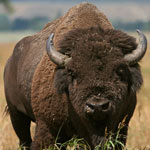
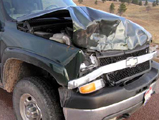

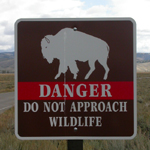
from Yellowstone National Park
From a study of injuries due to bison encounters in Yellowstone National Park:
“During 1980–1999, a total of 10 of 35 bison encounters (29%) involved photography (1); the majority of persons were ≥10 ft (3 m) from the bison, unlike the 3–6 ft (1–2 m) reported with recent photography-related injuries.
Smart phones now meet the needs of most casual photographers. Smart phones are owned by 64% of American adults, and 67% of smart phone owners report using their phone to share pictures and videos (6).
The popularity of smart phone photography with its limited zoom capacity and social media sharing of selfies might explain why visitors disregard park regulations and approach wildlife more closely than when traditional camera technology was used. Educating visitors about wildlife behavior and the need to maintain distances of 75–300 ft (23–91 m) from wildlife for safety of persons and wildlife is critical. Injury prevention campaigns that identify and target the underlying motivations of visitors to not comply with viewing distances might prevent future injuries.”
is from a CDC (Centers for Disease Control and Prevention) Morbidity and Mortality Weekly Report (MMWR)
https://www.cdc.gov/mmwr/volumes/65/wr/mm6511a5.htm
describes what people were doing before a bison charged them, and injuries they received.
This photographer might have thought he was far enough away because he had a wall between him and the bison, but bison are capable of hopping quickly over walls:
– – – – – – – – – – – – – – – – – – – – – – – – – – – – – – – – – – – – – – – – – – – – – – – – – – – – – – – – – –
These are from National Park news releases and local newspapers:
– – – – – – – – – – – – – – – – – – – – – – – – – – – – – – – – – – – – – – – – – – – – – – – – – – – – – – – – – –
CBS news reported “A couple that fell to their deaths at Yosemite National Park while taking a selfie in October reportedly had alcohol in their systems at the time.”
San Jose Mercury News reported: ”
Bay Area couple who fell to their deaths from Yosemite’s Taft Point were intoxicated. . .”
“Two people who died after falling more than 800 feet from a scenic overlook at Yosemite National Park in October had alcohol in their systems and were intoxicated at the time of the incident, according to autopsy reports.”
At the upper left is the railing at the official Taft Point, the only possibly “safe” place to get near the edge:
We watched a man hold the back of a woman’s daypack as she took photos at the edge of the Taft point viewpoint, (perhaps to protect her from falling over the high railing?)
– – – – – – – – – – – – – – – – – – – – – – – – – – – – – – – – – – – – – – – – – – – – – – – – – – – – – – – – – –
“Teen falls to his death in Yosemite National Park after trying to take a selfie
By Bryant-Jon Anteola, Fresno Bee
September 05, 2018 09:13 PM
Updated September 06, 2018 11:58 AM
A teenager who was visiting from Israel died Wednesday in Yosemite National Park while reportedly trying to take a selfie.
Israel’s Foreign Ministry identified the teen as 18-year-old Tomer Frankfurter, and local sources confirmed the death.
Frankfurter apparently lost his balance while trying to take a photo of himself at the edge of Nevada Fall before falling 820 feet to his death, the teen’s mother told The Times of Israel.”
– – – – – – – – – – – – – – – – – – – – – – – – – – – – – – – – – – – – – – – – – – – – – – – – – – – – – – – – – –
People ignore warnings /signage about being too close to animals, even when others nearby try to re-warn them
From the NPS Daily report
“Thursday, July 23, 2015
Yellowstone National Park (ID,MT,WY)
Woman Injured In Encounter With Bison
A 43-year-old woman from Mississippi received minor injuries Tuesday when she turned her back on a bison to get a photo with it near the Fairy Falls trailhead. She was the fifth person injured after approaching bison this season.
The woman and her daughter were by the trailhead sign when they decided to take a picture with a bison that was approximately six yards away from them near the trail. When they turned their backs to the bison to take the picture, someone warned that they were too close. They heard the bison’s footsteps moving toward them and started to run, but the bison caught the mother on the right side, lifted her up and tossed her with its head. The woman’s father covered her with his body to protect her and the bison moved about three yards away. The family drove to the Old Faithful Clinic, where the woman was treated and released with minor injuries.
“The family said they read the warnings in both the park literature and the signage, but saw other people close to the bison, so they thought it would be OK,” said Old Faithful District Ranger Colleen Rawlings. “People need to recognize that Yellowstone wildlife is wild, even though they seem docile. This woman was lucky that her injuries were not more severe.”
The park has again reminded visitors that wildlife should not be approached, regardless of how tame or calm they appear. When an animal is near a trail, boardwalk, parking lot, or in a developed area, visitors must give it a wide berth and not approach it closer than the required minimum distances – 25 yards away from all large animals (bison, elk, bighorn sheep, deer, moose, and coyotes) and at least 100 yards away from bears and wolves.
Bison can run three times faster than humans can sprint and are unpredictable and dangerous. Visitors are advised to give the animals enough space and alter their plans to avoid interacting with an animal in close proximity.”
– – – – – – – – – – – – – – – – – – – – – – – – – – – – – – – – – – – – – – – –
YELLOWSTONE NATIONAL PARK NEWS RELEASE
“Boy Injured By Yellowstone Bison June 27, 2008
A 12-year-old Pennsylvania boy was flipped in the air by a bison near the Grand Canyon of the Yellowstone this morning.
A mature bull bison, apparently annoyed at the close proximity of the boy, tossed him approximately 10 feet in the air. Witnesses said the boy was posing with members of his family within 1-2 feet of the animal despite repeated warnings from other visitors. The incident occurred just off the trail adjacent to the Uncle Tom’s Trail parking lot along the South Rim Drive of the Grand Canyon of the Yellowstone.
The bull’s horns did not puncture the boy. The only outward injuries he suffered were abrasions possibly received from hitting the ground after the fall.
Because the boy complained of abdominal pain, he was transported by ambulance to the Lake Clinic and then flown to the Eastern Idaho Regional Medical Center in Idaho Falls. The name and hometown of the injured juvenile aren’t being released. His current condition is not available.
Visitors are urged to be very cautious around the park’s wildlife. Extremely serious injuries or death can result from approaching wild animals too closely even if they appear docile. Park regulations require that a minimum distance of 100 yards be maintained from bears and wolves, and 25 yards from all other animals.”
– – – – – – – – – – – – – – – – – – – – – – – – – – – – – – – – – – – – – – – – –
from the National Park Service Morning Report Tuesday, July 16, 2002
“Yellowstone NP (WY) – Visitor Gored by Bison
A bull bison gored 37-year-old Paul Jocelyn of Albertville, Minnesota, near Old Faithful Lodge on the afternoon of July 13th. Witnesses said that the bison was grazing near the boardwalk that connects the lodge with Old Faithful geyser. A group of visitors approached to within ten to fifteen feet to take pictures of the animal. Jocelyn stepped out from the group and walked around to the front of the bison to see if it would raise its head for a better picture. The bison chased Jocelyn into the trees, picked him up with his horns, and threw him three to four feet into the air. The bison then stared at Jocelyn and the other visitors for several minutes before walking off and resuming grazing. Jocelyn sustained a puncture wound to his inner right thigh and various scrapes and bruises. Rangers provided initial care; he was then taken to Old Faithful Clinic for treatment of his injuries. Criminal charges are pending against Jocelyn for harassing wildlife. No action will be taken against the bison. [Public Affairs, YELL, 7/15]”
_____________________________________________________________
Some museums have bans on any photography.
A beach in southern France has banned all selfies, which are referred to as “braggies” because it spoils the beach experience for others. ” ( —-) beaches are among the most glamorous and pristine beaches in all of France. . . We want people to be able to enjoy our exclusive beach in the moment, not spending the majority of their time bragging to their friends and family back home.”
Train stations in Japan banned selfie sticks. “Many facilities have overhead wiring or other apparatuses that the company fears can be affected or damaged by being struck by the selfie stick, or through electric shocks triggered by close proximity to the smartphone even if no direct contact occurs.”
Some of the places that ban selfies have instituted fines ($500-$1,000 or even more) because people ignore the rules.
_____________________________________________________________
People in a hurry to get a photo have forgotten
to set their car in park and set the brake.
from the NPS Morning Report
“July 30, 2015
Acadia National Park (ME) Visitor Seriously Injured When Car Rolls Over Her
On the morning of July 27th, a 38-year-old visitor sustained potentially life-threatening injuries in an accident that occurred on the Park Loop Road near the Champlain North Ridge Trailhead.
Witnesses said that members of a family got out of their vehicle at a scenic pull-off along the road and that shortly thereafter the vehicle rolled backwards towards other vehicles, park visitors, and oncoming traffic. While family members attempted to stop it by pushing against the vehicle’s exterior, the driver attempted to reenter to apply the brakes.
The vehicle, however, gained momentum due to the steep slope and they were unable to stop it. In the process of attempting to enter the moving vehicle, the driver was knocked to the ground by the open car door and was subsequently overrun by the front wheel. The vehicle crossed the road and came to rest in the ditch and against the base of a cliff. The driver was transported by Bar Harbor Ambulance to a waiting Life Flight helicopter, where she was transported to Eastern Maine Medical Center in Bangor, Maine.
Investigating rangers determined that the car’s shifter was not in the ‘park’ position. The driver sustained multiple chest injuries but is in stable condition. “
____________________________
from the NPS daily report April 12, 2006
“Badlands National Park (SD)
Pedestrian Hit By Car, Life Saved
On April 12th, rangers were notified of a vehicle/pedestrian accident at the Yellow Mounds Overlook. Responding personnel determined that a pedestrian had been run over by a motor vehicle and was trapped beneath the vehicle. She was freed and basic life support was begun. A life flight was requested because she kept drifting in and out of consciousness. Air transport was expedited through the use of prearranged landing sites coordinated between the park and life flight. The woman was airlifted and taken to the Rapid City Regional Hospital, where she was treated for head, neck, spine and leg injuries.
Investigators determined that she had stepped out of her vehicle to take several photographs when she noticed that the vehicle was starting to roll. In an attempt to stop the moving vehicle, she reached through the open door to grab the gear shift lever, but was caught by the door and pulled beneath the vehicle. It then came to rest after striking a raised curb, trapping her underneath. “
____________________________
from the NPS daily report September, 2005
“Rocky Mountain National Park (CO)
Fatal Accident on Old River Road
A motor vehicle accident on the afternoon of September 12th claimed the life of John Whatmough, a 32-year-old visitor from Nashua, New Hampshire. The accident occurred on Old Fall River Road approximately one half mile above Chasm Falls.
The preliminary report indicates that Whatmough and his wife got out of the vehicle to take photographs. Their two-and-a-half year old son was in the backseat of the vehicle, restrained in a child safety seat.
The Hyundai began to roll backwards and Whatmough attempted to stop the car by opening the driver’s side door and getting in. The car traveled backwards for 25 feet down a steep, rocky embankment, dragging Whatmough along, before it came to rest. Whatmough sustained multiple traumatic injuries and died at the scene. The child was uninjured. [Submitted by Kyle Patterson, Public Affairs Officer] ”
____________________________
from the NPS daily report Tuesday, June 17, 2003
“Yellowstone National Park (ID,MT,WY)
Three Injured in Accident at Bear Jam
Three park visitors were injured on the evening of June 10th when a vehicle struck them as they were watching two black bears grazing in a meadow near Calcite Springs, approximately one mile from Tower Junction in the northeast section of the park.
Just prior to the accident, a ranger directing traffic at the location noted that a number of visitors had parked their vehicles off to one side of the road, then crossed to the other side to better view the bears. The ranger was in the process of clearing traffic when he glanced behind him and saw an unoccupied white Chrysler PT Cruiser roll away from its parked position, cross both lanes of traffic, plow into the crowd, and continue down a ten-foot embankment.
One victim, a seven-year-old girl, was knocked down, run over, and partially trapped under the vehicle; two other victims – the seven-year-old’s sister (eleven years old) and an older male (age unknown) – were struck and knocked out of the way by the vehicle. Most of the spectators did not see the vehicle coming.
By the time the ranger reached the accident scene, bystanders had moved the seven-year-old out from under the vehicle. The ranger immediately called for assistance. Rangers and staff from throughout the northern portion of the park responded and provided emergency medical care. The two girls were transported by helicopter to Eastern Idaho Regional Medical Center in Idaho Falls for additional care; the man was transported by ambulance to Livingston Memorial Hospital in Livingston. The seven-year old is listed in stable condition; she has two fractured ribs and some difficulty in breathing. Her sister was treated for an injury to her left arm and released. The man received some cuts and lacerations and was also treated and released. Park staff also provided emergency medical care for anxiety to two witnesses at the scene – one of them the owner of the vehicle, the other a woman visitor. Both were treated at the scene and released.
[Submitted by Public Affairs]”
see also: Cell phones in the wilderness which has advice on how/when to use a cell phone to contact 911 in the wilderness and a warning about interference between cell phones, iPods and avalanche beacons.
___________________________________
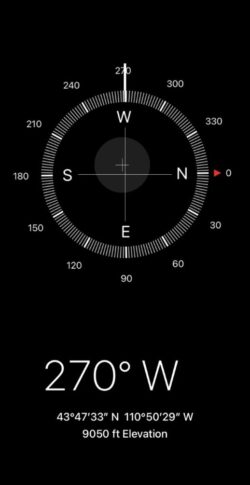
Find a compass, altitude, latitude and longitude on your cell phone
___________________________________
Thunderstorm and lightning safety includes a warning about not using your cell phone or IPod during a storm.
Hiking Advice has hot weather hiking advice, hiking logistics and the answer to the question: When is the best time of day to cross a mountain stream?
fatal, near fatal or close call incidents/accidents in camping, backpacking, climbing and mountaineering is a collection of some of the true stories I use in my wilderness first aid class to illustrate how the wilderness is not dangerous, it’s the people who aren’t prepared, who don’t know what they are doing, or who take inordinate risks, that are the danger.
Safe distances from wildlife includes reasons to stay away from even friendly seeming animals in parks and charts and photos to better be able to determine and visualize how far away from wildlife you need to stay to be safe (and obey laws that do have penalties).

Everyone who was taped in this one-minute duration video
should have been getting far away from these elk,
not staying to watch or photograph (even hiding between their cars):
Where were they when they got that great picture in Yosemite?
Where can I take a photo that looks like the one on a Yosemite postcard I just bought?
Places to take photos of Half Dome, Bridalveil Fall, El Capitan, Yosemite Falls and Staircase Falls.
______________________________________________
Please stay on the trail:
The poster above is from the advice page: http://www.friendsofyosar.org/#!water/voa96
______________________________________________
“Choosing to leave the trail and scramble in boulders below waterfalls can have a costly outcome. Is getting closer really worth the risk?”
https://www.facebook.com/YosemiteNPS/videos/462862757639618/
(Note to on-line users not in my classes: this is a study sheet. It is not complete instruction in the topic named in the webpage title.)
The author of this webpage, (written as a homework reading assignment for my students), does not give any warranty, expressed or implied, nor assume any legal liability or responsibility for the accuracy, completeness, or usefulness of any information, product, or process included in this website or at websites linked to or from it. Users of information from this website assume all liability arising from such use.
